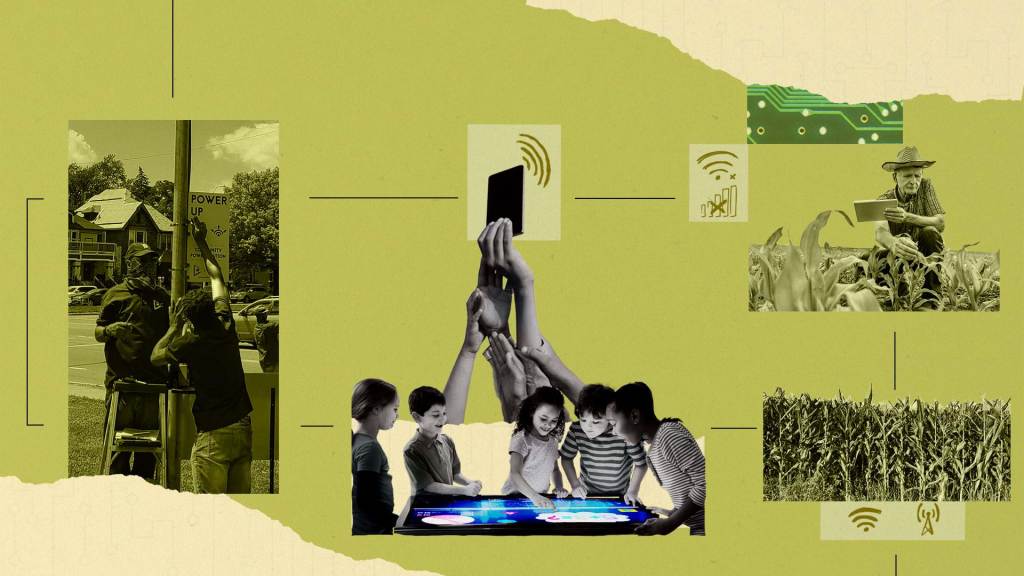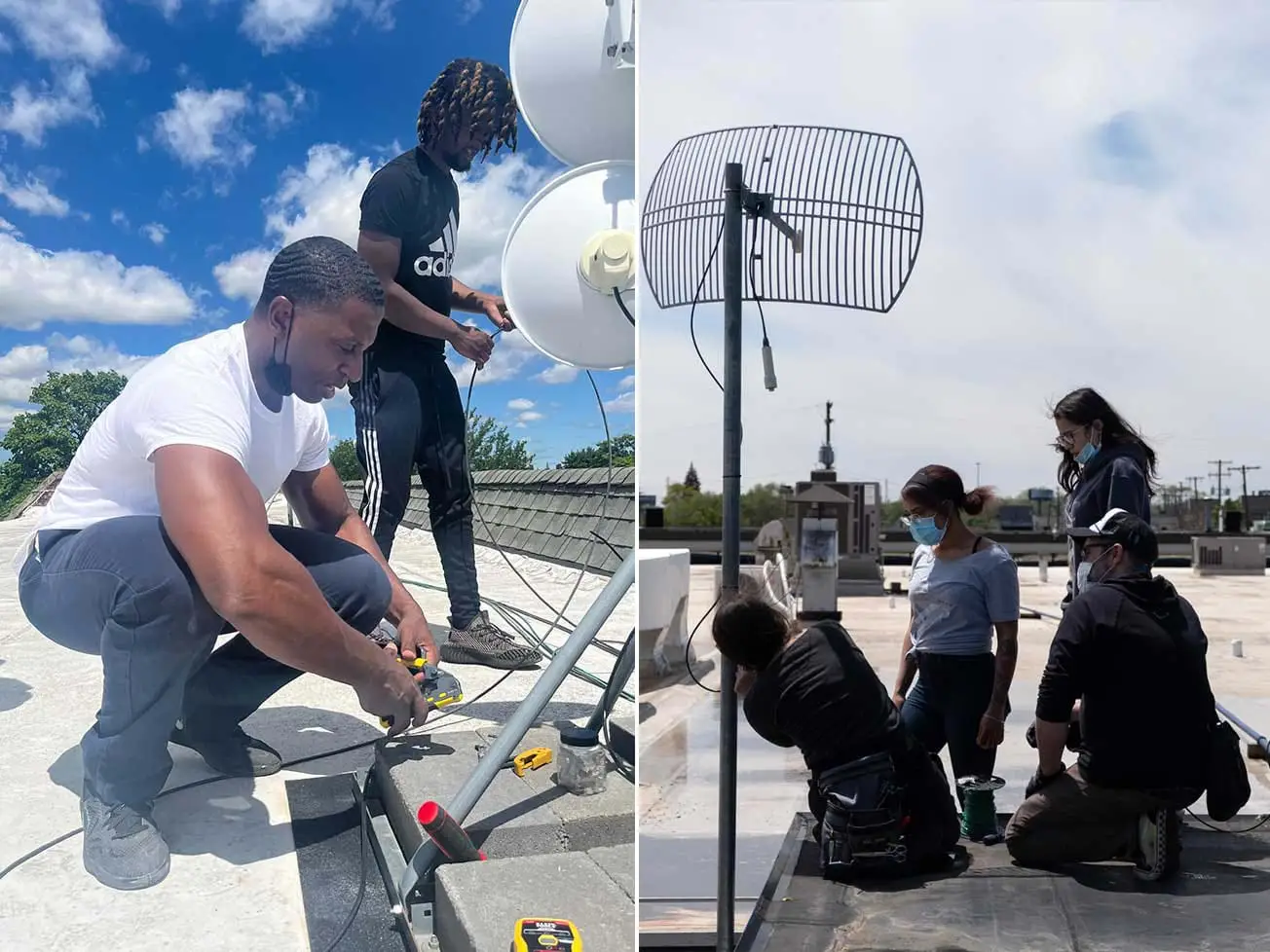 GETTY / THE DETROIT COMMUNITY TECHNOLOGY PROJECT
GETTY / THE DETROIT COMMUNITY TECHNOLOGY PROJECTIn 2020, during spring break of her senior year at Washington University in St. Louis, Mary Gay was told not to return to campus. The school’s chancellor informed its student body that, due to the ongoing COVID-19 pandemic, learning would shift online and commencement was canceled. It was shocking news, but then Gay heard another interrupted school story that put hers in perspective.
“There’s a Bond County, Illinois, town where the only reliable internet is at a veteran’s bar,” said Gay, who is currently completing a two-year fellowship with American Connection Corps, an organization that helps bridge the digital divide in heartland communities. “During the day, there would be 6-, 7-, and 8-year-olds sitting at the bar doing their schoolwork in the same space where 70- and 80-year-olds were drinking. That’s just not a conducive learning environment.”
By mid-2020, there was no dearth of internet access horror stories. In eastern Arizona, Autumn Lee drove 45 minutes to the nearest McDonald’s to download lectures and class assignments from the University of New Mexico. Near Charlotte, North Carolina, author Beth Revis sat in her SUV and taught a two-hour evening writing class from a closed elementary school parking lot. In Los Angeles, special education elementary school teacher Jaime Lozano experienced endless internet outages.
Limited internet affected other sectors, too. A March 2022 study by University of Chicago researchers found that lack of internet access, which correlates with race, was a consistent high-risk factor for COVID death in both rural and urban areas.
Broadband as necessity, not luxury
Twenty months into the pandemic, the Biden Administration reached the Bipartisan Infrastructure Deal. It acknowledged that broadband internet costs are prohibitive for many Americans and cited research from the Office for Economic Cooperation and Development stating that the United States has the second-highest broadband costs of 35 countries. The deal promised $65 billion to “help ensure that every American has access to reliable high-speed internet.”
One pandemic silver lining is that the connectivity conversation changed. “Broadband isn’t regulated like a utility, but it is as important as electricity,” said Gigi Sohn, long-time public interest advocate and former FCC senior staffer. “If you want to run a business, pay a parking ticket, operate a successful farm, check your finances, or get your kids to do their homework, you need it.” Before March 2020, she explained, there were still policymakers who labeled broadband a luxury and adamantly opposed its inclusion in the infrastructure bill. “That kind of nonsense is finally finished,” said Sohn. “Everyone knows broadband is a necessity if you want to be a full participant in modern society.”
 DETROIT COMMUNITY TECHNOLOGY PROJECT
DETROIT COMMUNITY TECHNOLOGY PROJECTThe Detroit Community Technology Project provides low-cost, high-speed internet for Detroit’s underserved communities to increase digital literacy and empower residents to become digital stewards. Members seen here installing wireless antennas at residences in Detroit.
“This is the number one economic issue of our time,” said Angie Cooper, the executive vice president of the Ford-funded nonprofit Heartland Forward. The organization has a “heartland initiative” that ensures that American families have the tools to fully participate in the modern world—especially the internet. Cooper called the federal funding “fantastic” but said that communities need help understanding and navigating eligibility requirements. The White House’s $14 billion Affordable Connectivity Program (ACP), reached in December 2021, is a case in point: It helps eligible households cut $30 per month off their internet bills. The problem is that it was initially offered online.
“A lot of people didn’t even know it existed,” said Cooper. In response, Heartland Forward bought billboard ads, ran radio spots, and sent out flyers to publicize ACP. Working with the League of United Latin American Citizens, the organization reached over 300,000 Hispanic homes.
Disrupting the digital divide
The U.S. Department of Commerce first recognized the digital divide in a 1995 paper. The agency wrote that the inequality in internet access impedes inclusive economic growth, particularly in Black communities. Today, the problem persists along the same racial lines. One analysis found that 40% of Black American households lack access to high-speed, fixed broadband. That figure drops to 28% for white American households.
People need proper digital training, said Christopher Mitchell, director of the community broadband networks initiative at The Institute for Local Self-Reliance, a Ford grantee. “The organizations best equipped to do this work are the ones that are already in the community,” he said. “It doesn’t matter if it’s a rural area or an urban one. You cannot parachute in and expect that people will trust you.”
A self-described “dial-up baby,” Katie Hearn is director of the Detroit Community Technology Project (DCTP), a Ford grantee that builds neighborhood-governed community wireless networks. Hearn was the first kid on her block to have a computer and AOL and has long noticed the disparity between people with internet access and those without it. Detroit, she said, was once one of the country’s worst-connected cities and a “poster child for digital redlining.” DCTP helped change that by training residents as community technologists, called digital stewards. They build and maintain digital networks and create solar-powered hotspots. Digital stewards also ensure that low-income households in Detroit— where the average median income is $26,249—can fully engage in all aspects of society. “We are transforming folks’ relationship with technology and also equipping them to become actual builders of the technology,” said Hearn.
Affordable, accessible, and available
Today, an estimated 42 million Americans have no access to broadband—and there is an unprecedented opportunity to change this. On June 26th, the Department of Commerce announced the Broadband Equity Access and Deployment program: a $42.45 billion grant program to connect states, territories, and the District of Columbia with high-speed internet infrastructure. Two days later, we joined the Media Democracy Fund, Democracy Fund, and W.K. Kellogg Foundation to announce a philanthropic collaborative. The Digital Equity and Opportunity Initiative (DEOI) supports state broadband coalitions as they implement the federal funding. The first round of grants focuses on the rural South.
There is strong consensus that community ownership of networks is key to ending the digital divide. “We can’t default to a top-down situation and assume that the government and the corporate entities know best,” said Hearn. “If we do that, we’re just going to create a new flavor of the digital divide.” There is little incentive for for-profit internet service providers to guarantee prices or access. In contrast, community-owned networks “have a tendency to provide service at a much lower cost and make sure that everyone has high-speed internet,” said Sohn.
Whether it is through targeted, multi-funder collaboratives like the DEOI or other initiatives, foundations have a key role to play in the next five years. “We need philanthropy to stay involved,” said Mitchell. “Funders can make sure that high-quality internet access is affordable and that people have the training to actually use it.”
Related Grantees
